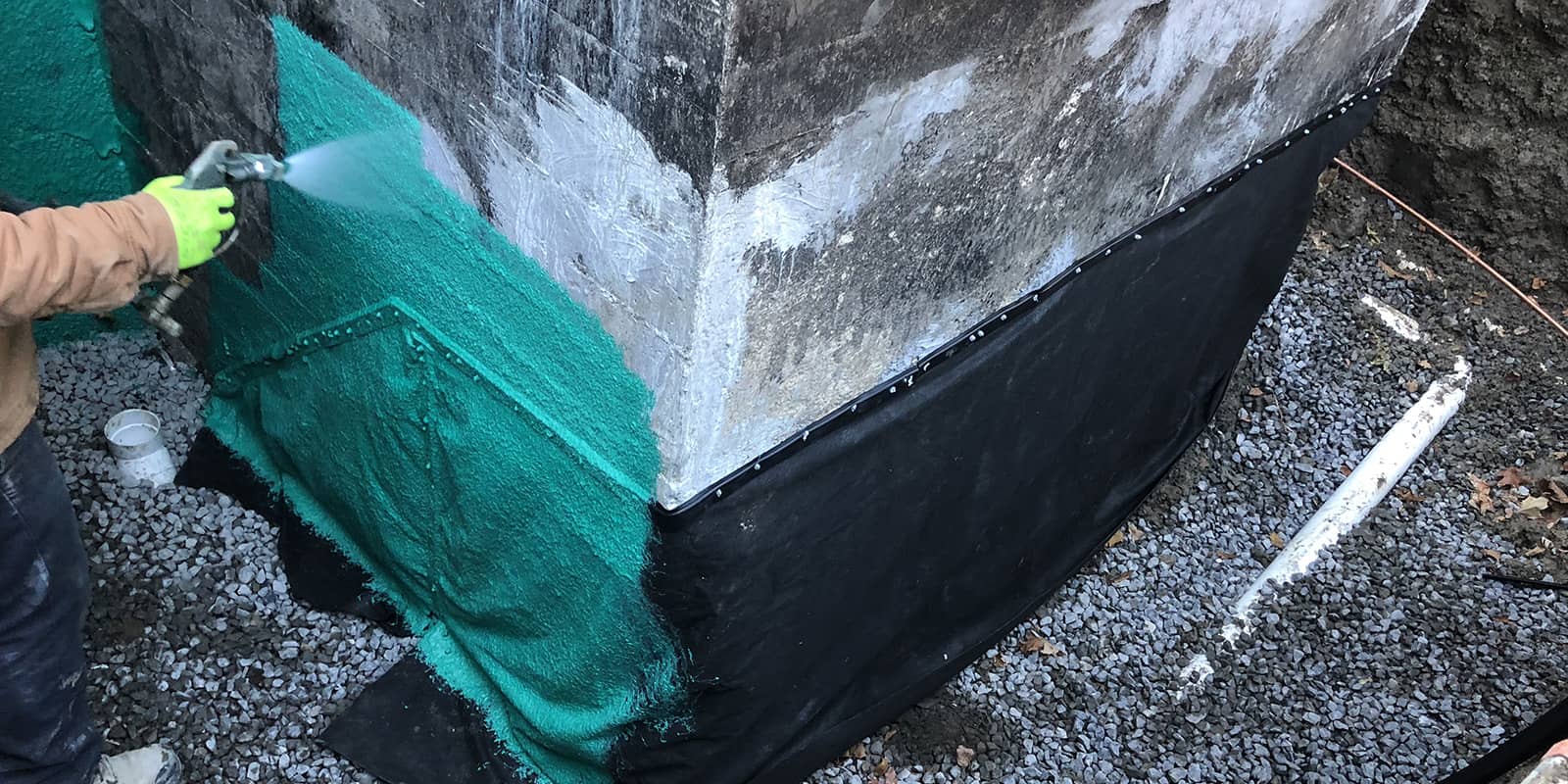With the Quebec climate as we know it, it is important to properly insulate the foundation of a building. By doing so, you put the odds on your side to avoid the risk of infiltration or large accumulations of water, especially during freezing or thawing. In addition, by insulating your concrete foundation, you will see a considerable reduction in your heating and air conditioning costs, you will have tighter control over the humidity level and the temperature of your basement, in addition to reducing the risks on your health in the long term.
Waterproofing, why is it important ?
As we mentioned, the change of seasons as well as ground movements can cause relatively large cracks in your house foundation. Since concrete is a porous material, insulating the foundations provides protection against degradation, but also acts preventively against water-related risks.
If you have the chance, it will cost you less to carry out the waterproofing at the beginning of the construction of your building, rather than carrying out this intervention in the future. This reduces the risk of any damage that may occur inside and out while offering resistance to moisture for your living spaces.
Your house foundation insulation needs a reliable and effective process that will make your building 100% waterproof. To do this, we will use the Rub-R-Wall sprayed polymer waterproof membrane. Applied in liquid form by spraying, this product adheres to all types of foundations that are located at ground level. This membrane has many advantages, particularly in terms of performance and results, which are superior to products available in stores like expanded and extruded polystyrene.
The magic of the membrane happens when it dries – the product forms a waterproof, rubberized 1 mm barrier, which provides protection for many, many years and saves you many headaches. A durable solution that reduces the risk of damages resulting in significant financial costs while giving you a lot of advantages that other types of insulation can’t give you.
What are the risks for a house without foundation insulation?
If your building foundation does not have insulation, you will notice a humidity level of around 50 to 60 %. There are also risks of water infiltration (water infiltrating through cracks), humidity between the ground and the foundation, condensation and frost located between the membrane and the foundation as well as the efflorescence of concrete (white spots located on the surface of concrete walls and having the shape of clouds). All this humidity can not only affect the basement walls but the integrity of all your house like degrading wood frame walls on upper floors.
On the other hand, a well-insulated exterior wall foundation will maintain a humidity level in the basement of around 30 to 40 %, which is an optimal level. By opting to insulate your foundation, you reduce the risk of the proliferation of fungi and mold that are highly harmful to health, but you also reduce the costs associated with heating and air conditioning your home, since the humidity level in the basement is lower.
The benefits of insulating with Rub-R-Wall
The use of the Rub-R-Wall sprayed polymer membrane offers incomparable energy efficiency and water repellency. Here are the many advantages of choosing this solution:
- The polymer material has superior durability to tar and any other material available on the market
- The membrane is an ecological product, does not contain any tar and does not release any chemicals in water, soil or water table
- The Rub-R-Wall membrane can be installed in all seasons, down to temperatures as low as 4°C
- It retains its original elasticity, even at very low temperatures (-26°C)
- The membrane protects your foundation from cracks up to 3.2 mm wide (⅛ in)
Forget about rigid foam insulation or mineral wool : with the Rub-R-Wall membrane, you have peace of mind for the lifetime of your home, since it offers a durability that exceeds 100 years and is guaranteed for life. This is the only foundation protection that promises you unlimited maximum effectiveness. You are moving? All you have to do is transfer the warranty to the new owner!
The process of insulating your foundation in 9 steps
Thanks to the elasticity of the membrane and the process put in place by Groupe Durasec, water and humidity from the ground no longer have a chance to infiltrate, whether it be, by cracks, however small they may be (⅛ inch) or by capillarity (phenomenon by which moisture rises in the foundation walls, from the footings).
 Step 1
Step 1
An application of the Rub-R-Wall membrane in 3 coats
Applied by spraying, the Rub-R-Wall membrane offers exceptional adhesion and is 100 % waterproof.
 Step 2
Step 2
Installing the Geo-Wrap plastic
The Geo-Wrap membrane is an essential component of the drainage system. Made up of a three-dimensional polypropylene base, it offers great resistance and protects the Rub-R-Wall coating from the risk of deterioration. It also accentuates the rapid drainage of runoff water that is located along the foundation walls. Possessing a water-repellent capacity, the Geo-Wrap membrane insulates the foundations from the earth, which improves the humidity level in the basement as well as better control over the ambient temperature.
 Step 3
Step 3
The geotextile filter film
The composition of the filter fabric of the Geo-Wrap membrane ensures the retention of the backfill and allows water to flow without resistance and easily along the membrane, in addition to drying the soil faster.
 Step 4
Step 4
Inserting plastic molding and mastic joint
The mastic finishing molding seal that we apply reduces all risks of water infiltration between the Geo-Wrap, Rub-R-Wall membranes and the building foundation. In this way, the risks associated with condensation as well as the development of mold between the various components are avoided.
 Step 5
Step 5
Installation of the cover membrane
The main function of the geotextile membrane is to isolate the gravel surrounding the French drain from the earth, sand or clay that constitutes the backfill. This membrane prevents the material that makes up the soil from mixing with the water and circulating through the gravel, which could eventually block the drain. It therefore offers a protective barrier to the French drain.
 Step 6
Step 6
Adding POLWHITE® film
This adhesive film is installed at the junction of the footing and the foundation walls. Since this area is generally more sensitive, it eliminates the risk of infiltration and ensures adequate flow of water to the drain.
 Step 7
Step 7
Insertion of a lower geotextile membrane
By inserting the membrane, we prevent the material of which the soil is made (soil, sand, clay, etc.) from mixing with the water and reaching the drain. Without this geotextile membrane, the drain could quickly become clogged, causing significant material damage and financial costs.
 Step 8
Step 8
Filling with gravel
We lay down a sufficient layer of ¾ inch gravel, which significantly accelerates the flow of water towards the drain. Performing this step is essential to keep the foundation dry, while reducing the water pressure produced by the water table.
 Step 9
Step 9
Installation of the French drain
Designed in rigid PVC, the pipes with which we work comply with BNQ standards. We use 4 inch pipes since they are strong, durable and easy to clean. By using rigid pipes, we are assured that the French drain will remain in place, that it will not be deformed or crushed by the pressure of the backfill. Also, it prevents the risk of damage or obstruction caused by the roots present in the soil.
You now know the importance of insulating your foundations from the outside. Know that it is essential to contact a professional whose expertise is such as Groupe Durasec to carry out this intervention. In addition to requiring a great deal of meticulousness and precision, calling on a specialized team will ensure the guarantee for the work carried out as well as an extension of the life of your foundation.

